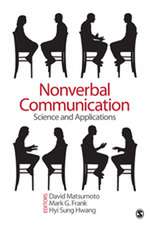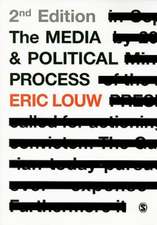Intercultural Communication: A Global Reader
Autor Fred E. Jandten Limba Engleză Paperback – 23 sep 2003
Conflict management in organizations
The impact of the Internet and of online global communication
Gender differences in communication
The increasing influence of globalization
Health care
Creating a culture of peace
Half of the readings are from non-U.S. authors/scholars, presenting readers with a truly global perspective on intercultural communication.
The Reader may be used as a stand-alone text, an excellent companion to Fred E. Jandt's textbook An Introduction to Intercultural Communication: Identities in a Global Community, Fourth Edition, or in conjunction with other texts. The book is intended for the introductory intercultural communication course and is also of value for many courses in cultural studies, sociology, and anthropology.
Preț: 792.48 lei
Preț vechi: 1085.58 lei
-27% Nou
Puncte Express: 1189
Preț estimativ în valută:
151.64€ • 158.75$ • 125.47£
151.64€ • 158.75$ • 125.47£
Carte tipărită la comandă
Livrare economică 05-19 aprilie
Preluare comenzi: 021 569.72.76
Specificații
ISBN-13: 9780761928997
ISBN-10: 0761928995
Pagini: 464
Dimensiuni: 187 x 232 x 24 mm
Greutate: 0.77 kg
Ediția:New.
Editura: SAGE Publications
Colecția Sage Publications, Inc
Locul publicării:Thousand Oaks, United States
ISBN-10: 0761928995
Pagini: 464
Dimensiuni: 187 x 232 x 24 mm
Greutate: 0.77 kg
Ediția:New.
Editura: SAGE Publications
Colecția Sage Publications, Inc
Locul publicării:Thousand Oaks, United States
Cuprins
To the Reader
Part I: Cultural Values
1.1 Race, History, and Culture - Claude Levi-Strauss
1.2 Business Cultures - Geert Hofstede
1.3 Human Factors on the Flight Deck: The Influence of National Culture - Ashleigh C. Merritt and Robert L. Helmreich
1.4 Conflict Management in Thai Organizations - Rujira Rojjanaprapayon, P. Chiemprapha, and A. Kanchanakul
1.5 An Examination of Taoist and Buddhist Perspectives on Interpersonal Conflicts, Emotions, and Adversities - Rueyling Chuang
1.6 Cultural Values and Argumentative Orientations for Chinese People in Taiwan, Hong Kong, and Mainland China - Jung-huel Becky Yeh and Ling Chen
1.7 Information Accessibility, User Sophistication, and Source Credibility: The Impact of the Internet on Value Orientations in Mainland China - Jonathan J. H. Zhu and Zhou He
1.8 What is the Basis of American Culture? - M. Gene Aldridge
Part II: Language
2.1 Babel Revisited - Peter Muhlhausler
2.2 Africa: The Power of Speech - Amadou Hampate Ba
2.3 Mexican American Ethnicity in Biola, CA: An Ethnographic Account of Hard Work, Family, and Religion - Eric Aoki
2.4 Korean's Politeness Strategies - Kil-Ho Kang
2.5 Online Communication Between Australians and Koreans: Learning to Manage Differences that Matter - Hee-Soo Kim, Greg Hearn, Caroline Hatcher, Ian Weber
2.6 Language Choice Online: Globalization and Identity in Egypt - Mark Warschauer, G. R. El Said, and A. Zohry
2.7 Research and Context for a Theory of Maori Schooling - Wally Penetito
2.8 Naming the "Outsider Within": Homophobic Pejoratives and the Verbal Abuse of Lesbian, Gay and Bisexual High-School Pupils - Crispin Thurlow
Part III: Identities
3.1 Decoding Domination, Encoding Self-Determination: Intercultural Communication Research Processes - Fred E. Jandt and Delores V. Tanno
3.2 Gender Differences in Communication: An Intercultural Experience - Becky Michele Mulvaney
3.3 Acculturation, Communication, and the U.S. Mass Media: The Experience of an Iranian Immigrant - Flora Keshishian
3.4 Reconfiguring Borders: Health-Care Providers and Practical Environmentalism in Cameron County, Texas - Tarla Rai Peterson, S. J. Gilbertz, K. Groenendyk, J. Todd, & G. E. Varner
3.5 Nuestro Espacio Cyber: The Internet as Expressive Space for Latinos in the United States - Richard D. Pineda
3.6 Nike's Communication with Black Audiences - Ketra L. Armstrong
3.7 Toward Theorizing Japanese Interpersonal Communication Competence from a Non-Western Perspective - Akira Miyahara
3.8 Differences in the Perception of Face: Chinese Mien-Tzu and Japanese Metsu - Kiyoko Suedo
Part IV: Living Together in Peace
4.1 On Intercultural Rhetoric - William J. Starosta
4.2 The Concept of an Intercultural Philosophy - Ram A. Mall
4.3 Women's Rights as Human Rights--Rules, Realities, and the Role of Culture: A Formula for Reform - Berta Esperanza Hernandez-Truyol
4.4 Mediating Conflict in Central America - Paul Wehr and John Paul Lederach
4.5 Islamic Mediation Techniques for Middle East Conflicts - George E. Irani
4.6 Creating a Culture of Peace: The Performing Arts in Interethnic Negotiations - Kjell Skyllstad
Part V: Colonialization and Globalization
5.1 Nobel Lecture - Wole Soyinka
5.2 Consumerism: Its Hidden Beauties and Politics - Ashis Nandy
5.3 Interculturalism in Singapore: Looking for the Big, Bad Other - William Peterson
5.4 The Impact of Universities on Globalisation - Lalita Rajasingham
5.5 Globalization, Informatization, and Intercultural Communication - Randy Kluver
5.6 Five Ways to Reduce the Foreign Terrorist Threat to the United States - Mohan R. Limaye
Part I: Cultural Values
1.1 Race, History, and Culture - Claude Levi-Strauss
1.2 Business Cultures - Geert Hofstede
1.3 Human Factors on the Flight Deck: The Influence of National Culture - Ashleigh C. Merritt and Robert L. Helmreich
1.4 Conflict Management in Thai Organizations - Rujira Rojjanaprapayon, P. Chiemprapha, and A. Kanchanakul
1.5 An Examination of Taoist and Buddhist Perspectives on Interpersonal Conflicts, Emotions, and Adversities - Rueyling Chuang
1.6 Cultural Values and Argumentative Orientations for Chinese People in Taiwan, Hong Kong, and Mainland China - Jung-huel Becky Yeh and Ling Chen
1.7 Information Accessibility, User Sophistication, and Source Credibility: The Impact of the Internet on Value Orientations in Mainland China - Jonathan J. H. Zhu and Zhou He
1.8 What is the Basis of American Culture? - M. Gene Aldridge
Part II: Language
2.1 Babel Revisited - Peter Muhlhausler
2.2 Africa: The Power of Speech - Amadou Hampate Ba
2.3 Mexican American Ethnicity in Biola, CA: An Ethnographic Account of Hard Work, Family, and Religion - Eric Aoki
2.4 Korean's Politeness Strategies - Kil-Ho Kang
2.5 Online Communication Between Australians and Koreans: Learning to Manage Differences that Matter - Hee-Soo Kim, Greg Hearn, Caroline Hatcher, Ian Weber
2.6 Language Choice Online: Globalization and Identity in Egypt - Mark Warschauer, G. R. El Said, and A. Zohry
2.7 Research and Context for a Theory of Maori Schooling - Wally Penetito
2.8 Naming the "Outsider Within": Homophobic Pejoratives and the Verbal Abuse of Lesbian, Gay and Bisexual High-School Pupils - Crispin Thurlow
Part III: Identities
3.1 Decoding Domination, Encoding Self-Determination: Intercultural Communication Research Processes - Fred E. Jandt and Delores V. Tanno
3.2 Gender Differences in Communication: An Intercultural Experience - Becky Michele Mulvaney
3.3 Acculturation, Communication, and the U.S. Mass Media: The Experience of an Iranian Immigrant - Flora Keshishian
3.4 Reconfiguring Borders: Health-Care Providers and Practical Environmentalism in Cameron County, Texas - Tarla Rai Peterson, S. J. Gilbertz, K. Groenendyk, J. Todd, & G. E. Varner
3.5 Nuestro Espacio Cyber: The Internet as Expressive Space for Latinos in the United States - Richard D. Pineda
3.6 Nike's Communication with Black Audiences - Ketra L. Armstrong
3.7 Toward Theorizing Japanese Interpersonal Communication Competence from a Non-Western Perspective - Akira Miyahara
3.8 Differences in the Perception of Face: Chinese Mien-Tzu and Japanese Metsu - Kiyoko Suedo
Part IV: Living Together in Peace
4.1 On Intercultural Rhetoric - William J. Starosta
4.2 The Concept of an Intercultural Philosophy - Ram A. Mall
4.3 Women's Rights as Human Rights--Rules, Realities, and the Role of Culture: A Formula for Reform - Berta Esperanza Hernandez-Truyol
4.4 Mediating Conflict in Central America - Paul Wehr and John Paul Lederach
4.5 Islamic Mediation Techniques for Middle East Conflicts - George E. Irani
4.6 Creating a Culture of Peace: The Performing Arts in Interethnic Negotiations - Kjell Skyllstad
Part V: Colonialization and Globalization
5.1 Nobel Lecture - Wole Soyinka
5.2 Consumerism: Its Hidden Beauties and Politics - Ashis Nandy
5.3 Interculturalism in Singapore: Looking for the Big, Bad Other - William Peterson
5.4 The Impact of Universities on Globalisation - Lalita Rajasingham
5.5 Globalization, Informatization, and Intercultural Communication - Randy Kluver
5.6 Five Ways to Reduce the Foreign Terrorist Threat to the United States - Mohan R. Limaye
Notă biografică
Descriere
Intercultural Communication: A Global Reader contains 36 articles showcasing the development and diversity of intercultural communication theories in countries such as China, Africa, the United States, New Zealand, Mexico, Egypt, and others. Themes and topics discussed include identity and communication, intercultural verbal and nonverbal processes and interactions, relationships, and ethics.
The Reader may be used as a stand-alone text, an excellent companion to Fred E. Jandt's textbook An Introduction to Intercultural Communication: Identities in a Global Community, Fourth Edition, or in conjunction with other texts. The book is intended for the introductory intercultural communication course and is also of value for many courses in cultural studies, sociology, and anthropology.
The Reader may be used as a stand-alone text, an excellent companion to Fred E. Jandt's textbook An Introduction to Intercultural Communication: Identities in a Global Community, Fourth Edition, or in conjunction with other texts. The book is intended for the introductory intercultural communication course and is also of value for many courses in cultural studies, sociology, and anthropology.









